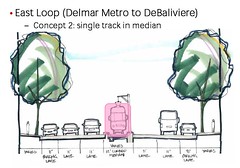Following the Loop Trolley open house held two weeks ago at the Missouri History Museum, Justin Chick at Transit Turning Point expressed his concerns regarding the Loop Trolley’s proposed fare collection and hours of operation. Justin and other individuals at the open house also expressed concern about the potential capacity limitations of single tracking on Delmar Blvd. The limitations imposed by the single track alignment will have the greatest impact on any future system expansion.
Quick Project Overview
As proposed, the Loop Trolley is a $43 million project that will run 2.2 miles with 9 stations extending from Trinity Ave near the Lion’s Gate in the Delmar Loop to the Missouri History Museum in Forest Park. Initial service will be a trolley every 20 minutes. It is hoped that in future years trolley ridership will support service running every 10 minutes. Ridership is projected to be 800 per day on weekdays and 2,000 per day on weekends when the trolley first opens and is anticipated to grow to 2,600 per day on weekdays and 4,000 per day on weekends by 2030.

West of the Delmar MetroLink station, tracks will run in each direction, positioned in the traffic lanes. In order to cut costs, only a single track will be built east of the MetroLink Station, running in the Delmar median. At DeBaliviere Ave., the trolley will turn south towards the Missouri History Museum, running on a single track in a dedicated greenway on the east side of the street. A small siding near DeBaliviere Ave will allow trolleys heading in opposite directions to pass.
The Limitations of Single-Tracking
Inadequately explored by the EA report, however, is how severely the large proportion of the single-tracking will limit the capacity of the Loop Trolley and its options for later expansion. From Page 6 of Appendix 3.4:
Joe Edwards mentioned that […] the plan has always been to have additional extensions, starting with Forest Park and possibly expanding to Kingshighway, the Central West End, Grand and beyond.

The Draft EA makes a future year assumption of 10-minute headways for the trolley line. However, the study also states both operating scenarios studied with 10-minute headways were proven infeasible: trolleys running in opposite directions met in sections with only a single track. Operating scenarios with 12, 15, and 20 minute headways were shown to be functional.
Also stated as possible was an operating scenario in which trolleys ran every 10 minutes through the heart of The Loop, but just every 20 minutes east of the MetroLink station. Either way, the final EA must find a workable operating plan with 10-minute headways or more clearly explain that 10-minute headways will only ever occur west of the MetroLink station.
In fact, the final EA report should place a very strong emphasis on finding a workable operating plan with 10-minute or better headways. This is because the the capacity limitations of single-tracking along Delmar Blvd will become doubly important if the decision is ever made to extend the trolley to the Central West End and beyond.

Extending the Loop Trolley east on Delmar Blvd to the Central West End would require a 2-line system much like MetroLink operates today. With 20-minute headways considered a minimum acceptable service on any branch of the future trolley system, the entire stretch of Delmar Blvd from DeBaliviere Ave to Trinity Ave would see 10-minute headways. The system would then experience a single-track bottleneck. If a workable operating plan with 10-minute headways cannot be presented, expansion of the Loop Trolley will never happen.
![]() Cross-posted at nextSTL.
Cross-posted at nextSTL.

Since this line replicates MetroLink, single-tracking may not be so bad. Future extensions to the CWE and/or within Forest park should ideally have more frequency than this "duplicating branch" to the Loop.